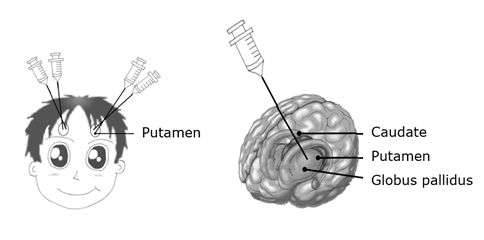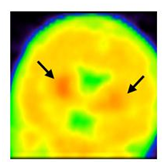Gene Therapy for Aromatic l-Amino Acid Decarboxylase Deficiency
Primary investigator: Wuh-Liang Hwu
National Taiwan University Hospital, Taipei, Taiwan
What is aromatic L-amino acid decarboxylase (AADC) deficiency
- It is an inherited metabolic disease caused by mutations in the DDC gene
- This is a very rare disorder but its incidence is higher in Taiwan than in western countries
Clinical Manifestations of AADC deficiency
- Severe dopamine and serotonin deficiency
- Hypotonia, Oculogyric crisis, Dystonia
- Autonomic system dysfunction
- Early death
- Poor response to medications
Principle of gene therapy for AADC deficiency
- A adeno-associated virus serotype 2 (AAV2) viral expressing the human AADC cDNA (AAV2-hAADC)
- The vector was injected into bilateral putamen of patients by stereotactic surgery
- AAV2-hAADC produces dopamine in putamen and relieve the motor disability of patients

Method of gene delivery
- The surgery is very similar that for deep brain stimulation
- Two burr holes will be made on each side of the skull
- Through each burr hole, each putamen will be injected twice
- This is a one-time treatment

Figure 1: Explanation of the stereotactic surgery. Left panel illustrates the four injections through two burr holes. Right panel indicates the injection site, the putamen.
Clinical trials
The Phase 1/II trial (NCT01395641): Completed, this trial treated 10 patients. All patients revealed improved in motor function and decrease in the severity of oculogyric crisis attacks.

Figure 2: FDOPA positron emission tomography (PET) study revealed the visualization of bilateral putamens after gene therapy.
The Phase IIb trial (NCT02926066): Ongoing, this trial includes two-dosages in patients younger than 3 years.
Achievements of the clinical trial
- Technology transfer: Agilis Biotherapeutics, LLC , Dec 2015
- Orphan Drug Designation, FDA, June 2016
- Rare Pediatric Disease (RPD) designation, FDA, Nov 2016
- Orphan Medicinal Product (OMP) designation, EU, Dec 2016
Collaborators
- Jichi Medical University, Japan
- Powell Gene Therapy Center, University of Florida, USA
Publications
Science Translational Medicine 2012 May 16;4(134):134ra61.